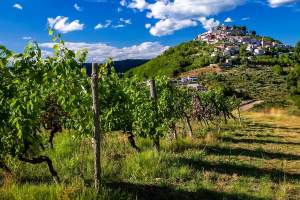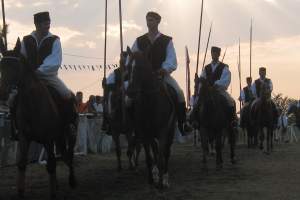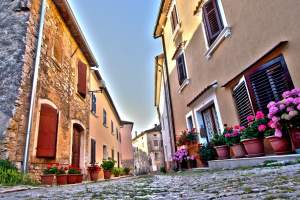Vodnjan-Dignano
Vodnjan-Dignano is a small town in the southwest of Istria, around 12 km from Pula, positioned at 135 meters above sea level. The town was formed on the remains of prehistoric hill forts.
A legend says Vodnjan-Dignano developed out of the association of seven fairies which were a part of Pula’s colonial property. In order to survive the constant feud between the Patriarch of Aquilea and the Venetians, the seven villas (Vodnjan-Dignano, Mednjan, Guran, Saint Quirinus, Mandriol, Saint Michael of Banjole and Saint Lawrence) organize into one town: today’s Vodnjan-Dignano.
Its wide area with typical little stone houses called kažuni, built from dry walls, that marked land property, is a witness to the millennium during which its inhabitants based their material prosperity on agriculture, especially olive growing and winegrowing.
The Ancient Romans, after having defeated the Histri, the indigenous people of this area (2nd century B.C.), inhabited permanently this area.
In 2nd century B.C., the territory of Vodnjan-Dignano was guarded by certain Attinivs. At the time, it was known as VICUS ATTINIANUM, the name from which ADIGNANI, DIGNANO originates. The Croatian peasants are responsible for the Slavic transcription, they used to carry the baskets loaded with their own products and run to the marketplace...first to Dinjane, then Vodnjane and finally to Vodnjan-Dignano.
In historic record Vodnjan-Dignano dates back to 932 and the first written record of Vodnjan-Dignano dates back to 1194 in a court decision mentioning Poponis de Adignanis.
After the fall of the Roman Empire, life in Vodnjan-Dignano continued under the rule of the Ostrogoths (Barbarians) and the Byzantine Empire. The first destruction happened in 751 when Vodnjan-Dignano was attacked by the Langobards and the Avars, and with Charles the Great came the reign of feudalism.
In the attempt of gaining at least a limited autonomy, the people of Vodnjan-Dignano decide that they would benefit more if they succumbed to the Venetians, under whose rule they were until the fall of the Serenissima (1797).
Having gained considerable importance, in 1330 Vodnjan-Dignano separates from Pula-Pola and gets its own Venetian governor.
The Statute of Vodnjan-Dignano, which regulates private and public law, dates back to that time and cultural surroundings (13th century). Its value was confirmed by its long existence and the fact that its provisions remained into effect for more than four centuries until the Austrian rule.
After the fall of the Venetian Republic, during the Austrian rule, once more Vodnjan-Dignano became a part of Pula. From 1805 until 1813 Istria was in the transition period of the Napoleon rule, and from 1814 until 1918 it is again under the Austrians and due to its strategic geographic position becomes even more significant as an important traffic junction.
The First and the Second World War bring big changes, and it is only in 1933 that Vodnjan-Dignano once again gains the status of municipality which today includes Galižana, Peroj, Barbariga and Gajana.
Inside the historic nucleus, the town preserved its characteristic medieval appearance with nooks and winding narrow streets, with cobble roads and facades made of cobble stone, old streets still markedly recognizable by their Gothic, Venetian, Renaissance and Baroque style and many churches rich with memories and artifacts.

















